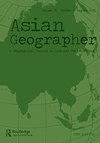印度农村转型的地区差异
IF 2.2
Q2 GEOGRAPHY
引用次数: 1
摘要
农业在印度国内生产总值(gdp)中的份额从1950-1951年的52%急剧下降到2017-2018年的不到17%,这必然意味着该部门可雇用的劳动力数量下降。然而,农业仍然是该国最大的雇主。即使工人离开农业部门,他们也并不总是离开农村地区。印度从农业经济向非农业经济的转变并没有与预期的从农村地区向城市地区的转变相匹配。我国面临的宏观形势是农业生产力低下,城市化速度缓慢,农村剩余劳动力巨大。但在全国范围内,劳动力从农业转移的情况是否存在差异?该国是否观察到一种以上的农村转型模式?这个国家是否有连续的地区有一个特定的过渡模式,这在一个地区是常见的?为了回答这些问题,本文首先仔细研究了该国观察到的不同类型的转型。然后,除了边缘工人占据显著位置的地区外,它还分别绘制了工人进入农业、离开农业但仍留在农村地区和完全离开农村地区的地区的地图。本文章由计算机程序翻译,如有差异,请以英文原文为准。
Regional variation in rural transition in India
ABSTRACT The dramatic decline in the share of agriculture in India’s gross domestic product from 52 percent in 1950–1951 to less than 17 percent in 2017–2018 necessarily implies a decline in the amount of labor this sector can employ. However, agriculture continues to be the largest employer in the country. Even when workers move out of the agricultural sector, they do not always leave rural areas. The movement from an agrarian economy to a non-agrarian one in India has not been matched by the expected shift from rural areas to urban areas. The macro scenario facing the country is that of low agricultural productivity, slow urbanization rates, and huge surplus labor in rural areas. But within this overall national picture, are there variations in terms of movement of labor away from agriculture? Are there more than one rural transition patterns being observed in the country? Are there contiguous areas in the country with a specific transition pattern which is common for a region? To answer these questions, this paper first takes a closer look at different types of transitions observed in the country. It then goes on to map the regions where workers have moved into agriculture, moved out of agriculture but remain in rural areas, and left the rural areas altogether respectively, in addition to regions with a prominent place for marginal workers.
求助全文
通过发布文献求助,成功后即可免费获取论文全文。
去求助
来源期刊

Asian Geographer
GEOGRAPHY-
CiteScore
3.30
自引率
0.00%
发文量
7
期刊介绍:
Asian Geographer disseminates knowledge about geographical problems and issues focusing on Asia and the Pacific Rim. Papers dealing with other regions should have a linkage to Asia and the Pacific Rim. Original and timely articles dealing with any field of physical or human geographical inquiries and methodologies will be considered for publication. We welcome, for example, submissions on people-environment interactions, urban and regional development, transport and large infrastructure, migration, natural disasters and their management, environment and energy issues. While the focus of the journal is placed on original research articles, review papers as well as viewpoints and research notes under the category of “Asian Geography in Brief” are also considered. Review papers should critically and constructively analyse the current state of understanding on geographical and planning topics in Asia. The ‘Asian Geography in Brief’ section welcomes submissions of applied geographical and planning research about Asia. The section aims to showcase (1) the diverse geography and planning of Asia; and (2) the diverse geographical and planning research about Asia. The journal will also publish special issues on particular themes or areas. Book reviews can be included from time to time.
 求助内容:
求助内容: 应助结果提醒方式:
应助结果提醒方式:


